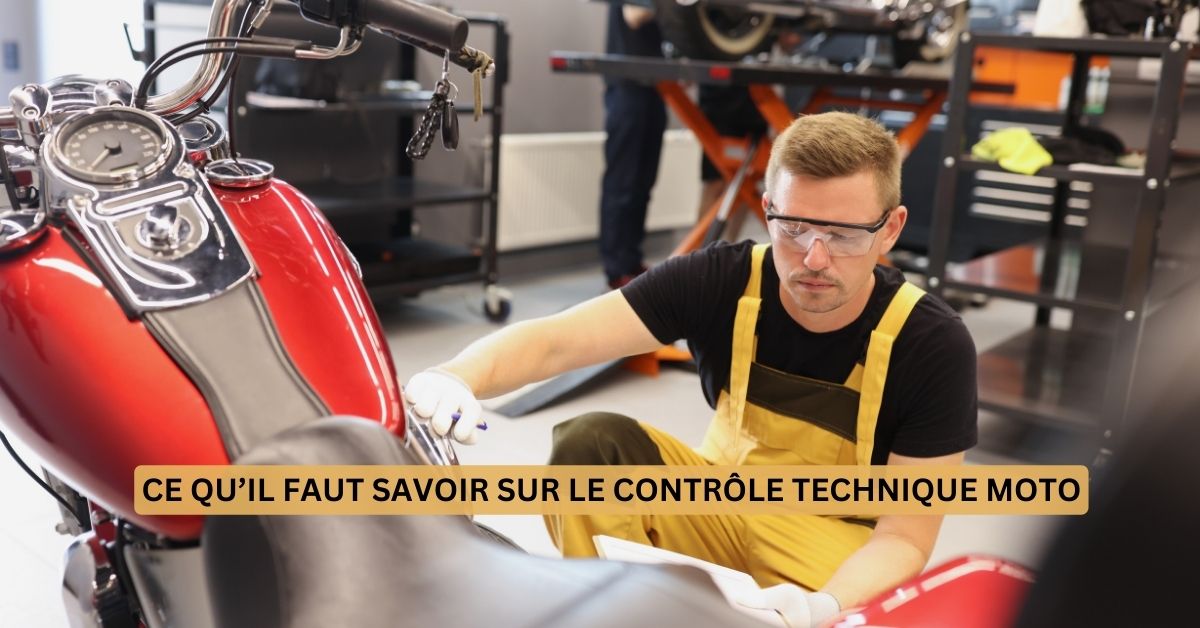WHAT YOU NEED TO KNOW ABOUT MOTORCYCLE TECHNICAL CONTROL
Technical inspection for motorcycles is a subject that raises many questions and discussions among motorcyclists.
While four-wheeled vehicles have been subject to regular inspections for decades, the idea of extending a similar technical inspection to motorized two-wheelers has been met with some reluctance by part of the motorcycling community.
In this article, we will explore the implications, objectives, and practical details of motorcycle technical inspection.
OBJECTIVES OF THE MOTORCYCLE TECHNICAL CONTROL
The main objective of motorcycle technical inspection is to improve road safety. By identifying and correcting technical problems likely to affect the safety of the motorcyclist and that of other road users, technical inspection aims to reduce the number of accidents. Another objective is to contribute to environmental protection by ensuring that motorcycle emissions remain within regulatory limits.
ITEMS CHECKED
The motorcycle technical inspection covers several essential aspects of the vehicle, in particular:
- Braking devices: checking the effectiveness and condition of the brakes.
- The direction : inspection for proper operation and absence of excessive play.
- The visibility : control of lighting devices, indicators, and signaling.
- Elements linked to pollution and noise: checking the level of emissions and the exhaust system.
- Safety equipment: inspection of tires, frame, and suspension.
FREQUENCY AND TERMS
The frequency of motorcycle technical inspections varies according to national regulations. In some countries, a first inspection may be required four or five years after the vehicle is first registered, followed by periodic inspections every two years.
The precise terms, including possible exemptions for collector vehicles or competition motorcycles, also depend on local legislation.
CONSEQUENCES OF UNFAVORABLE TECHNICAL CONTROL
If a vehicle does not pass the technical inspection, the owner is usually given time to carry out the necessary repairs and present the vehicle for inspection.
Riding a motorcycle that has failed a technical inspection can result in sanctions, ranging from a fine to immobilization of the vehicle.
PERSPECTIVES AND DEBATES
The introduction of motorcycle technical inspection has sparked a lively debate. Supporters point to potential benefits in terms of road safety and environmental protection.
However, voices are being raised to criticize the associated costs for motorcycle owners and question the real effectiveness of these measures in reducing accidents.
ECONOMIC IMPLICATIONS
The introduction of a motorcycle technical inspection can have significant economic implications, both for motorcycle owners and the motorcycle industry.
Owners may face additional costs for preparing and repairing their vehicles for inspection.
On the other hand, it could boost the motorcycle repair and maintenance market, providing new opportunities for repair shops.
IMPACT ON THE USED MARKET
Motorcycle technical inspections could also influence the used vehicle market. Motorcycles which have successfully passed the technical inspection may see their value on the second-hand market increase, while those which do not meet the criteria could depreciate. This can encourage owners to better maintain their vehicles.
TECHNOLOGIES AND INNOVATIONS
To meet technical inspection requirements, motorcycle manufacturers could be encouraged to integrate advanced technologies and innovations aimed at improving safety, reducing emissions, and increasing the durability of their models.
This could accelerate the development of new technological solutions in the motorcycle industry.
TRAINING AND AWARENESS
The implementation of a motorcycle technical inspection underlines the importance of training and raising awareness among motorcycle owners about the maintenance and safety of their vehicles.
Educational programs and awareness campaigns could be developed to help motorcyclists understand the benefits of regular maintenance and adopt safer riding practices.
REGULATORY ISSUES
Regulations around motorcycle technical inspections vary from country to country, reflecting different approaches to road safety and environmental protection.
Harmonizing standards at an international or regional level could be a challenge, but it would also offer an opportunity to establish consistent and effective criteria for motorcycle inspection.
Motorcycle technical inspection represents a significant change for motorcyclists and the motorcycle industry. While the safety and environmental goals are clear, practical implementation and acceptance by the motorcycling community remain challenges.
It is essential that regulations are accompanied by clear communication and consideration of riders' concerns to ensure the success of this initiative.
Motorcycle technical inspection represents a significant evolution in the approach to motorcycle safety and maintenance. While the debate over its effectiveness and impact continues, it is clear that its introduction will bring about notable changes for motorcycle owners, the industry, and society as a whole.
Adapting to these changes will require cooperation between governments, manufacturers, repair shops, and the motorcycle community to ensure that safety and environmental goals are met while minimizing negative impacts on motorcycle enthusiasts. .
WHERE TO PASS MY MOTORCYCLE TECHNICAL CHECK?
To pass the technical inspection of your motorcycle, you will need to contact an approved technical inspection center in your region or country.
The exact procedure and available options may vary depending on local law. Here are some general tips to guide you:
SEARCH ONLINE
- Official sites: Consult the website of the national or regional body responsible for road safety or transport. These sites often provide a list or map of approved technical inspection centers.
- Search engine : A quick search with terms like “motorcycle inspection [your city/region]” can provide you with addresses of approved centers near you.
- CONTACT YOUR DEALER OR REPAIR SHOP
CONTACT YOUR DEALER OR REPAIR SHOP
– Motorcycle dealers and repair shops can often recommend reliable and authorized technical inspection centers. In some cases, they can even take care of organizing the inspection for you.
USE MOBILE APPLICATIONS OR DIGITAL PLATFORMS
– Some mobile applications and online platforms specializing in automobile services offer functionalities for locating and making an appointment at a technical inspection center.
ASK BIKER ASSOCIATIONS
– Local motorcycle associations or clubs can be a good source of information. Their members can share their experiences and recommend technical inspection centers.
POINTS TO CONSIDER
- Accreditation: Make sure the center is officially accredited to carry out technical checks on motorcycles.
- Prices : Prices can vary from center to center, so it may be helpful to compare rates.
- Additional services: Some centers may offer additional services, such as minor repairs if needed to pass the inspection.
- BEFORE THE APPOINTMENT
BEFORE THE APPOINTMENT
- Prepare your motorcycle: Make sure your motorcycle is in the best possible condition before the inspection. Check key items like brakes, lights, tires, etc.
- Necessary documents : Find out about the documents you must bring on the day of the inspection (registration card, previous technical inspection report, etc.).
HOW TO PASS YOUR MOTORCYCLE TECHNICAL CHECK?
Passing the technical inspection of your motorcycle involves several steps to ensure that your vehicle complies with current safety and environmental standards. Here is a step-by-step guide to help you with this process:
CHECK THE NEED FOR CONTROL
- Age of motorcycle: Some regulations require a first technical inspection after a specific number of years since first registration, and then at regular intervals.
- Local regulations: Requirements may vary by country or region. Make sure you know the rules that apply in your geographic area.
- PREPARE YOUR MOTORCYCLE
PREPARE YOUR MOTORCYCLE
- Documentation: Gather all the necessary documents, such as the registration certificate (registration certificate) and, if applicable, the latest technical inspection report.
- Lighting and signage: Check the operation of the headlights, turn signals, brake lights, and license plate lights.
- Braking: Make sure the front and rear brakes are working properly.
- Tires: Check the condition of the tires, their wear, and make sure they are at the correct pressure.
- Suspensions: Check the condition of the front and rear suspensions.
- Exhaust : Check that the exhaust system is not damaged and meets noise and emissions standards.
- Visibility : Make sure the mirrors are secure and provide proper visibility.
- Leaks: Check for fluid leaks (oil, gasoline, brake fluid).
FIND A TECHNICAL CONTROL CENTER
Search online, ask your dealer or motorcycle friends for recommendations, and choose an authorized center to carry out motorcycle inspections
MAKE AN APPOINTMENT
Contact the chosen center to make an appointment. Some centers allow you to book online.
CHECK DAY
- Arrive on time: Bring your motorcycle and all necessary documents.
- Inspection: A technician will examine your motorcycle, checking several checkpoints to ensure compliance.
- Control report : At the end of the inspection, you will receive a report detailing any defects. If your motorcycle passes the inspection, you will obtain a certificate of conformity. In the event of serious defects, a second inspection may be necessary.
IN CASE OF COUNTER VISIT
If repairs are necessary, carry them out within the allotted time and return to the control center for the second inspection.
- ADDITIONAL TIPS
- Regular maintenance: Regular maintenance of your motorcycle can make it easier to pass the technical inspection.
- Documentation: Keep a copy of the technical inspection report with your motorcycle documents.
WHAT CRITERIA TO PASS YOUR TECHNICAL CONTROL?
To pass the technical inspection of your motorcycle, it is important to know the specific criteria evaluated during this inspection.
Although requirements may vary slightly from country to country, here is a general list of key checkpoints:
IDENTIFICATION AND DOCUMENTS
Verification of the concordance between the vehicle and the documents presented (registration card, registration certificate).
LIGHTING AND SIGNAGE
- Operation of headlights (high beam and low beam), position lights, turn signals, brake lights, and license plate lighting.
- Correct headlight adjustment.
BRAKING
- Condition and operation of front and rear brakes, including wear of brake pads and rotors.
- Tightness and condition of brake lines.
DIRECTION
- Steering clearance and condition.
- Correct alignment.
VISIBILITY
- Condition and fixing of the mirrors.
- Clarity and condition of the protective screen(s), if applicable.
EQUIPMENT
Presence and condition of mandatory equipment, such as the horn.
- WHEELS AND TIRES
- Condition of tires (wear, tears, inflation).
- Compliance of tire dimensions with the motorcycle model.
STRUCTURE AND CHASSIS
Inspection of the structure and chassis to detect possible deformation, significant corrosion, or cracks.
PENDANTS
Condition and operation of the front and rear suspensions.
EXHAUST SYSTEM
- Condition and fixing of the exhaust system.
- Compliance with noise and polluting emissions standards.
ENGINE AND TRANSMISSION
- Absence of leaks (oil, fuel).
- General operation of the engine.
GENERAL CLEANLINESS AND OVERALL CONDITION
Verification that the vehicle does not present any safety risks due to its general condition.
PREPARATION TIPS
- Carry out a preliminary check of your motorcycle based on these criteria.
- Repair or replace defective parts before inspection.
- Make sure your motorcycle is clean and well maintained, as this can –
- influence the evaluation.
It is recommended to consult the specific guidelines of the technical inspection body in your country or region for a detailed list of inspection criteria. This will help you better prepare your motorcycle for the technical inspection.








Fantastic beat ! I would like to apprentice while you amend your web site, how could i subscribe for a blog site? The account helped me a acceptable deal. I had been a little bit acquainted of this your broadcast offered bright clear concept